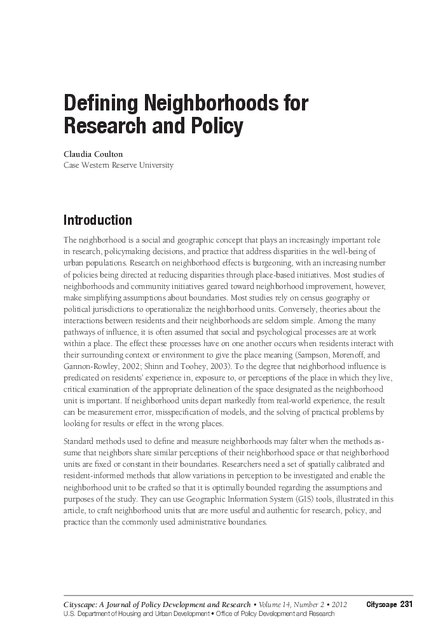
The neighborhood is a social and geographic concept that plays an increasingly important role in research, policymaking decisions, and practice that address disparities in the well-being of urban populations. Research on neighborhood effects is burgeoning, with an increasing number of policies being directed at reducing disparities through place-based initiatives. Most studies of neighborhoods and community initiatives geared toward neighborhood improvement, however, make simplifying assumptions about boundaries. Most studies rely on census geography or political jurisdictions to operationalize the neighborhood units. Conversely, theories about the interactions between residents and their neighborhoods are seldom simple. Among the many pathways of influence, it is often assumed that social and psychological processes are at work within a place. The effect these processes have on one another occurs when residents interact with their surrounding context or environment to give the place meaning (Sampson, Morenoff, and Gannon-Rowley, 2002; Shinn and Toohey, 2003). To the degree that neighborhood influence is predicated on residents’ experience in, exposure to, or perceptions of the place in which they live, critical examination of the appropriate delineation of the space designated as the neighborhood unit is important. If neighborhood units depart markedly from real-world experience, the result can be measurement error, misspecification of models, and the solving of practical problems by looking for results or effect in the wrong places. Standard methods used to define and measure neighborhoods may falter when the methods assume that neighbors share similar perceptions of their neighborhood space or that neighborhood units are fixed or constant in their boundaries. Researchers need a set of spatially calibrated and resident-informed methods that allow variations in perception to be investigated and enable the neighborhood unit to be crafted so that it is optimally bounded regarding the assumptions and purposes of the study. They can use Geographic Information System (GIS) tools, illustrated in this article, to craft neighborhood units that are more useful and authentic for research, policy, and practice than the commonly used administrative boundaries.
Resource collections
- UN Habitat - Urban Response Collection
- Urban Response - Urban Crisis Preparedness and Risk Reduction
- Urban Response Collection - Community Engagement and Social Cohesion
- Urban Response Collection - Economic Recovery
- Urban Response Collection - Environment and Climate Change
- Urban Response Collection - Housing, Land and Property
- Urban Response Collection - Urban Crisis Response, Recovery and Reconstruction
- Urban Response Collection - Urban Resilience